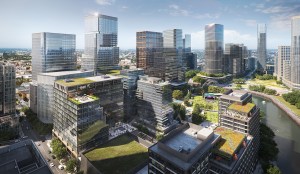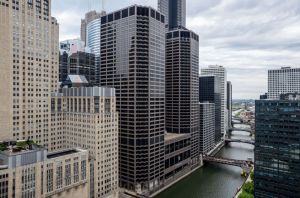Chicago’s Office Market Slow to Adapt
Despite significant leasing activity earlier this year, the city’s vacancy rate remains among the highest in the nation.
Chicago’s office market, like all major U.S. metros, continued to be defined by users and owners looking for solutions to the sector’s crisis. During the first four months of the year, vacancy remained elevated across the board, new construction starts hinted that some developers are still positive on office properties, while transaction activity slowed down to a quarter of what it was last year.
The life science sector is gaining traction in Chicago as well, providing a potential exit ramp to traditional office users. Another potential factor to watch out for is conversion of office properties, such as the recently announced project by Brennan Investment Group in the I-90 Corridor submarket.
Dive in our latest Chicago office market breakdown for the first four months of the year, with data provided by CommercialEdge.
Construction starts grew year-over-year
In April, Chicago had 3.7 million square feet of office space under construction, which represented 1.2 percent of existing stock. The metro’s pipeline remained 60 basis points below the national construction rate. Some of the largest properties underway are projects initiated before the remote work shift, leaving owners and developers to look for solutions in how to best utilize the space.
Development activity was concentrated in the metro’s CBD, which had 2.3 million square feet of office space underway. Other submarkets with notable amounts of space under construction included West Loop (560,000 square feet), South Chicago (410,000 square feet) and Eastern East-West Corridor (328,000 square feet).
Two office properties were completed during the first four months of the year, totaling 765,000 square feet—less than half of the almost 2 million square feet delivered during the same period last year. The largest property that came online during this time was the owner-occupied Joan & Paul Rubschlager Building at Rush, a 480,000-square-foot medical office building in the West Loop submarket. The $450 million medical facility opened in February, and it serves as a center for neuroscience and cancer care.

A Chicago mega-development, Lincoln Yards was approved by the city in 2019. The mixed-use community, to be developed on former industrial land along the North Branch of the Chicago River, will span 53 acres. Image courtesy of Sterling Bay
The other building that was completed is situated within Sterling Bay’s Lincoln Yards project—a 53-acre mixed-use development. The developer finished a 285,000-square-foot office building at 1229 W. Concord Place, which is aimed at tenants in the growing life science sector.
During the first four months of the year, construction or redevelopment activity began across four properties totaling 1.5 million square feet—a far cry from the 78,000 square feet that broke ground last year during the same period. More than half of this space was within a single building—Onni Group started redevelopment work at its 848,500-square-foot property in the metro’s CBD, at 225 W. Randolph St. The revamped building is slated to come online in 2024.
The largest property underway in April was Hines Interests’ Salesforce Tower, measuring 1.2 million square feet. Hines is developing the property in partnership with Salesforce, which was originally set to occupy 500,000 square feet at 333 Wolf Point Plaza. Reportedly, the company is currently looking to sublease 125,000 square feet of that space, considering current economic headwinds. Hines topped out the property last year, and expects to bring it online in June.
Traditional office vacancy not improving
Although the metro recorded some significant leasing activity during the first four months of the year, vacancy remained one of the highest in the nation, at 18.8 percent as of April. The figure was 210 basis points higher than the national rate. Chicago’s rate has improved by 60 basis points since January.
Compared to other gateway markets, Chicago had the second-highest office vacancy rate, exceeded only by San Francisco (19.4 percent). Manhattan took the third spot (16.8 percent), followed by Los Angeles (14.4 percent) and Miami (12.1 percent).
The average full-service equivalent listing rate was $27.9, significantly below the national average of $38.2 and up 2.4 percent year-over-year.
Office leasing mostly consisted of companies relocating and re-assessing their need for space. Additionally, office users are following the flight-to-quality trend in Chicago as well. In March, for example, law firm Hanley Flight & Zimmerman signed a 13,943-square-foot lease at Tishman Speyer’s CME Center in Chicago’s CBD, relocating to a Class A office.
Molson Coors Beverage Co. carried out another relocation, to Riverside Investment & Development’s 320 South Canal property, also in the CBD. The company signed an 83,848-square-foot lease, and is set to move its headquarters to floors 34 through 36 starting in the summer of 2024.
A biomedical research institute signed a 25,698-square-foot lease at Trammell Crow Co.’s 1375 W. Fulton office properties located in the West Loop submarket. The Chan Zuckerberg Biohub Chicago joined several other life science companies at the 725,000-square-foot campus.
Chicago office investment downshifted
Year-to-date through April, Chicago office transactions totaled $354 million, representing only 25.3 percent of the $1.4 billion recorded over the same period last year. The average price per square foot stood at $91, down 55 percent year-over-year and significantly below the national figure of $196.
The largest sale during this period was Agave Holdings’ $96.5 million purchase in the metro’s CBD. The company acquired the 512,354-square-foot property at 300 S. Wacker Drive at roughly $188 per square foot from Golub & Co. The LEED Gold-certified building received a cosmetic renovation in 2018.
Coworking remains a good opportunity
Meanwhile, coworking providers in Chicago are looking to capitalize on opportunities provided by the market’s state. Chicago’s massive office inventory allows for a large percentage to be dedicated to hybrid work environments, and likely more providers will enter the market this year. In April, the market had roughly 3.5 million square feet of shared space, representing 1.9 percent of the total office space available.
Compared to other gateway markets, Chicago remained on the third spot, with Los Angeles (2.2 percent) and Manhattan (2.8 percent) being the only metros that exceeded its offering of shared space.









You must be logged in to post a comment.